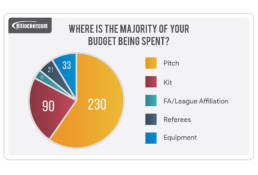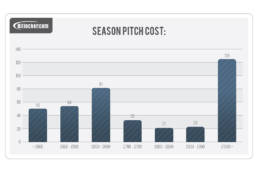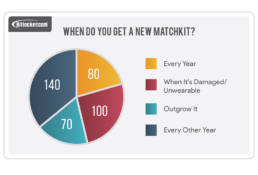Setting up a football team can seem like a daunting task, so we’ve collated a list of costs, hints and tips to get you up and running. Once you see past these costs, there are lots of benefits you can’t put a price on. You’ve enhanced your social circle, you’ve added an extra morning of being active to your week & you might just feel that bit fitter.
So, let’s get into it. The below costs are a necessity in setting up a team:
| Area | Cost |
| FA Affiliation | £80 (Season) |
| League Affiliation/Entry | £88 (Season) |
| Pitch | £500-£1000 (Council –> Private) |
| Kit | £250-£600 |
| Referee | £25-£35 per Game |
| Balls | e.g 5 at £10 = £50 |
The above figures are based on Sheffield & Hallamshire’s adult “Imperial League”, where 30 teams compete across 3 leagues. You can find out more about the league by clicking on the Sheffield & Hallamshire website here.
Prices do differ at junior level, however there will still be a cost for both FA and League affiliation.
Where’s your budget being spent?
We asked 390 of our social media followers who play, or are associated with a grassroots football team where the majority of their budget goes. The results reflected the costs above, with 59% of them saying the pitch was their most expensive outlay, followed by 24% who said the team’s kit.

Justifying the Costs
League and FA Affiliation are standard across all County FAs, but may vary slightly in cost. In some leagues you’ll also have to pay for cup entry, which in the Imperial League will cost £25, whether you decide to compete in it or not.
Your major cost for the season will be hiring a pitch. There is a big difference in what you can pay here, but it should be noted that the phrase “you get what you pay for” is extremely relevant. At the bottom end of that scale, you’ll be playing on a council pitch which will likely be uneven, have a questionable playing surface & will see games called off for even moderate rainfall.
Compare this with a pitch which grassroots teams are paying around £1,000+ for. This price bracket will likely give you the option of grass or an artificial surface, which has changing rooms and showers.
Interestingly, we found that 31% of respondents were paying more than £1,000 for a pitch, with only 25% paying less than £600. Are we seeing a shift in mindset as teams move away from value and lean towards quality? Only 25% of our respondents were not happy with the pitch they played on, coincidence?

A Kitlocker customer, Daniel Platts of Robin Hood FC said “last season we paid £650 for a pitch, and it was awful. This year we’ve paid £800 and the quality is much improved”.
Pitchfinder is a handy website where you can plug in your postcode and see pitches around you, there is even a convenient link to contact details for the pitch which takes your fancy.
The FA’s Grassroots Survey 2017 found that 63% of people raised the issue of a need for more artificial pitches. This suggests that if your area does have them, they’re being snapped up for next season early. Moreover, teams regularly struggle to get their games on over winter when the weather is much colder & wetter. It’ll be the teams playing on artificial surfaces that won’t be playing catch-up towards the end of the season, as teams try and arrange mid-week matches (when work commitments come before football).
The FA are looking to tackle this by introducing multi-pitch community football hubs throughout the UK, also know as ‘St George’s Park Local’, with Sheffield already having two, Graves (SGPGraves) and Thorncliffe (SGPThorncliffe). It’s stated on the Sport England website that the Hubs will be ‘affordable, open and accessible to all’. Great news for new and existing clubs in the area. We’re excited to see the hubs popping up over the country over the coming years.
Kit costs can vary massively, we’d know. As a new team, you’ll almost definitely have to bite the bullet and purchase circa 16 shirts. But where do you start? A breadth of brands, colours and styles to choose from add to your list of options. Check out our Match Kit Guide article to find out more about picking the right shirt for your team.
Kits give you the opportunity to secure some level of sponsorship or funding for your team by representing a brand on the shirt, our recent Sponsorship piece gives you a comprehensive insight into how your team can get sponsored.
As you can see below, a pretty even split of when teams purchase a new kit, it’d be fair to assume that those getting a new kit every season are being backed financially by a sponsor.

Referees are a fundamental part of any competitive fixture, expect to pay £25 per game for an FA qualified referee & 35p per mile for them to get to the venue. Of everyone on the pitch, referees have the hardest job of all, particularly with no assistance from another official, and should be treated with the upmost respect. That being said, respect is on the rise, the FA say there are 5,000 fewer red cards on average per season since 2008, and 25,000 less cautions for dissent since the respect campaign came into place.
See below for the card fine amount:
| Yellow Card | £15 |
| Red Card | £35 |
Further fines can be handed out by your respective County FA for failing to control players & not turning up for fixtures.
The final area you’ll need to think about is match balls (and training balls for those that do train). Kitlocker recently tested out four different Nike match balls and found that at a grassroots level, the following fits the bill:
Nike FA Charter Standard Match Ball: £12.57
Nike Strike Team Match Football: £13.46
Over 90% of teams order new balls every season, so you’ll need to find that balance between price & quality, especially when you’re purchasing them all over again in a years time.
Raising Funds to Cover the Costs
Now you’re familiar with the figures, you might be asking where do I get a minimum of £1,000 from to setup a football team? There are many ways to do so, we take a look at some techniques that some of Kitlocker’s customers have implemented to raise those much needed funds.
Shirt Sponsorship
We’ve already deduced from our Sponsorship article that there are two ways to secure a sponsor for your team, the tactical and personal approach. While some teams appeal closer to home through player’s families, some appeal to local businesses that’d benefit from the teams demographic. Which is exactly what Liam Akers of Staffordshire Arms FC did:
“We affiliated with a local pub, playing under their name in return for cash upfront. This arrangement was under the agreement that after each game, we’d take at least 11 players back to the pub”. Staffordshire Arms FC have since continued their partnership with the pub for a second year.
Don’t be disheartened if you don’t immediately find a sponsor, 64% of clubs do have one which suggests they are out there, you just need to look in the right places.
Spot The Ball, Race Nights & Other Pub Games
There are plenty of ‘back at the pub’ games which can raise funds for the team. £2 entry with 50% of all money collected going back into the team. Simple.
Bag Packing
Typically done by younger age groups, bag packing is a great way to earn extra cash for your team, you’ll have probably seen this across big supermarket chains such as Tesco, Asda & Morrisons. We recommend getting in touch with the store manager to arrange a time slot for your team. Adam Crapper, of Southey Wolves U12 recently completed a bag packing afternoon with his team, raising £125.
Let us know in the comment section down below if you’ve found any other successful fund raising activities that you’d be happy to share.
The Players
Every player should be contributing per game, this is to cover the costs of pitch and referee. On average, the ‘subs’ for a player are £5, with those coming off the bench normally paying £2.50 on a pro-rata basis.
Interestingly, when we asked our social media followers if they struggled to collect subs from players, 74% of them said they did. The simple answer here is “can’t pay? Can’t play”. That being said, if you’re short on players, it might not be the best approach. We’d suggest having a notebook where you can write down the names of every player, along with what they have/haven’t paid for that week. If they owe two weeks subs, look to collect that on the second week before you end up chasing them for £40/£50 halfway through the season.
In Summary
On first look, the costs to setup a team might seem overwhelming, as will competing with several other teams for the same sponsor and maybe even the same pitch. But as the FA invest £50m per annum into grassroots football, and 21% of adult male players look to increase their participation in 2018, amateur football is undoubtedly on the rise. In fact, between the FA, Premier League & DCMS, £1.3bn has gone into grassroots facilities since 2000. In 2015, the FA Grassroots survey found that 52% thought football was the best value for money sport.
If the figures above aren’t enough to coerce you into taking the plunge into grassroots football, then take the word of our social media followers for it. 92% of them said that playing, or being associated with a grassroots football team was a fundamental part of their week.
It seems to most, at least, that you really can’t put a price on football.
How useful was this post?
Average rating 4 / 5. Vote count: 61
No votes so far! Be the first to rate this post.

CAn you send this
500 to a 1000 pound quoted for pitch depending,but is that per game? Per what? Thanks